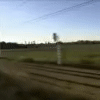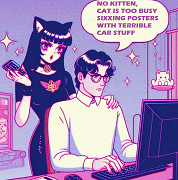|
Please take the time to read this. From the April 2016 issue of Railway Age, AAR President Ed Hamburger claims where PTC is in place, there is no need for two-man crews. There is little doubt what the Class 1's will ask for at National Negotiations.
|
|
|
|

|
| # ? May 9, 2024 22:46 |
|
Pigsfeet on Rye posted:Looks like CN lost a rail trestle due to a fire of unknown origin, and it happened in a spectacular fashion: That was all over my Facebook feed. Does anything good happen in Mayerthorpe?
|
|
|
|
 18 years ago when I first started working for them I couldn't sit still in my seat after sitting for 15 minutes. Today, I can sit for 6 or 8 hours, alone with nothing but my thoughts. Because they have "in-cab cameras" and you are not supposed to read, use your phone, nap, or do anything else but just sit there. I get their want for cameras. But enforcing distraction rules even when nothing else is going on? I guess I will adapt to this the way I have adapted to everything else. It is like being in a sensory deprivation chamber. Can people adapt to those things? Just saying.
|
|
|
|
You could sing. Pull Big Brother down into madness along with you.
|
|
|
|
B4Ctom1 posted:Please take the time to read this. From the April 2016 issue of Railway Age, AAR President Ed Hamburger claims where PTC is in place, there is no need for two-man crews. There is little doubt what the Class 1's will ask for at National Negotiations. Based on the last 10 big major US railroad accidents, 2 man crews would have prevented none of them unless they mandated 2 men in the cab at all times to prevent overspending, and PTC should prevent overspending, so his point is based on fact.
|
|
|
|
NoWake posted:You could sing.
|
|
|
|
nmfree posted:11 hours of "Baby Got Back" at full scream should do it See how long a coherent song you can loop the full version of Rapper's Delight into.
|
|
|
|
About ten minutes into the May 1 broadcast is a 20 minute segment with Sim Webb, Casey Jones's fireman, describing the famous accident.
|
|
|
|
Maybe I'm imagining it, but does this thread have a post detailing everything that goes into an accident investigation? Not referring to the big post about an accident where a freight train hits a bulldozer at a crossing, but I thought I read somewhere, maybe here, about what all goes into an accident investigation from the time of impact until the train gets running again.
|
|
|
|
Wilford Cutlery posted:Maybe I'm imagining it, but does this thread have a post detailing everything that goes into an accident investigation? Not referring to the big post about an accident where a freight train hits a bulldozer at a crossing, but I thought I read somewhere, maybe here, about what all goes into an accident investigation from the time of impact until the train gets running again. Super condensed version: Maintenance of Way will look for defects in the rolling stock & ask for data logs off the engine and the consist. Transportation will ask for track inspection records and look for loose bolts/missing anchors. Mechanical will cross-reference maintenance backlogs to throughput demands & ignored staffing requests.
|
|
|
|
NoWake posted:Super condensed version: Thanks. Are any of those taking place while the train is sitting there waiting to move again?
|
|
|
|
Wilford Cutlery posted:Thanks. Are any of those taking place while the train is sitting there waiting to move again? My scenario has the train (and some of the track) sitting in the ditch, if it's a simple re-rail the cause is usually pretty obvious. Broken rail will have rust in the joint if it's been cracked for a while, or if it's a clean break you look through the consist for broken/flat spotted wheels. If rusty, charge it to Track. If clean and bad wheels, charge it to Mechanical. For cars popped off the rail, you can check the gauge before the point of derail and eyeball the track for any suspect changes in cross level or alignment. Charge it on Track if it's loose and wobbly. If the train crew was shunting cars around or going too fast, charge it to Transportation. If the car's side bolsters are worn out and won't let the trucks negotiate the curve, charge it to Mechanical. Picked switches will either have warped switch rods from being run-through while not lined correctly, or wheel flanges thinner than spec picking the points or the frog. If the switch points, frog points or guard rails are worn out, charge it to Track. If the crew previously ran through it the wrong way, charge it to Transportation. If the wheel flanges are way thinner than spec, charge it to Mechanical. Accidents such as running through a red signal should more or less be obvious straight after, but sometimes it's a combination of events that can gently caress you. Here's an example: Transportation, against their own procedures, sends a fully loaded grain car down an empty track in a hump yard. The car skips through the inert retarder at the end of the yard, shares a track with a few empty corn syrup cars, and the accident & recovery tears up 3 switches. Track is found at fault because (due to low staffing) the retarder hadn't been checked that quarter, and is found to be out of adjustment. Transportation should be at fault since they'd gone against procedure; a correctly adjusted retarder wouldn't have stopped that car anyway. Going against procedure to save time (by not spotting a few empty cars first) trumps a missed inspection for lack of inspectors. Nevermind that the recovery bill likely cost more than 2 guys' full-time salary & benefits, but I guess insurance policies don't cover preventative maintenance. For anything short of the FRA or NTSB getting involved, It's more about covering your rear end and blaming others than doing your job.
|
|
|
|
Thanks. Sorry, I should have been more specific. My scenario is a pedestrian being struck & killed, typically by a passenger train.
|
|
|
|
Wilford Cutlery posted:Thanks. Sorry, I should have been more specific. My scenario is a pedestrian being struck & killed, typically by a passenger train. probably is basically: blame a cellphone
|
|
|
|
Wilford Cutlery posted:Thanks. Sorry, I should have been more specific. My scenario is a pedestrian being struck & killed, typically by a passenger train. Wow, didn't even think about that. After a crew change they'd walk the train to check cars and track condition after the emergency stop, a signal maintainer would check signal function, and I'd imagine logged data pulled from the equipment. Anything beyond that would be the call of the local PD or railroad police.
|
|
|
|
Cool. Reason I ask, I'm a member of an unofficial Facebook page for my local commuter rail. Pedestrian struck and fatally killed to death this morning. Somebody decided to rant on the page that things were taking too long to get the train moving again. The resulting thread is rather amusing. I know when I was on a train that carried out somebody's suicide, we sat for a bit over two hours before moving again. TITTIEKISSER69 fucked around with this message at 21:27 on May 2, 2016 |
|
|
|
So often with crimes, the criminal is someone that you trust: a volunteer firefighter is charged with a boatload of fires, including the one that destroyed a CN trestle. http://www.foxnews.com/world/2016/05/02/teen-volunteer-firefighter-charged-with-setting-string-blazes-helped-extinguish.html?intcmp=hplnws
|
|
|
|
NoWake posted:Awesome effort post... Thanks for that NoWake, it was interesting. What you said about insurance not covering preventive maintenance has me wondering. Obviously any private individual making a large insurance claim is going to get a rate hike, encouraging them to deal with problems before they get to that stage, but does the same happen to railroads? Someone like UP has to be such an enormously important customer that hiking their rates over accidents has to be a very carefully considered process. I would imagine it's something like, on an annual basis the insurance rate for a particular division is reviewed by the insurance company and adjusted based on cost of claims that year, so deferring maintenance because insurance will cover the inevitable accidents is a losing game long term. That said, if all you care about is making your division look good for this year so you get the bonus from cutting maintenance costs, then who cares about long term consequences right?
|
|
|
|
Exactly. Terminal managers have been known to kick cars from yard to yard and back again, because it'll reduce the average dwell time for cars in the yard and their numbers will look better. Let's say it's Monday and you've got 10 loaded cars arriving in your yard from points West, bound for a distributor on your territory. The local train servicing them only runs out of your yard three times a week, Mondays Thursdays and Saturdays, so those 10 cars will hit your 48+ hour bucket unless you do something about it. So let's get them moving! You sort them and attach them to the next outbound mixed freight headed.. who cares where really. The other yard receives them Tuesday evening, where they sit for 6 or 8 hours, and they get sorted and attached to a mixed freight headed back your way. Wednesday afternoon you get the cars back in your inbound yard, but they sit for 2 shifts before getting sorted because you're inundated with incoming traffic. They're sorted and sitting in the departure tracks mid-day Thursday, but by that time the morning local is long gone. Repeat until the load spoils or the customer stops giving you their business... but hey, you're really efficient at moving those cars through your yard!
|
|
|
NoWake posted:Exactly. Terminal managers have been known to kick cars from yard to yard and back again, because it'll reduce the average dwell time for cars in the yard and their numbers will look better. the obsession with metrics, especially metrics of low value, is the worst part about my job. i'm forced to do things that are counter productive because i dont want to appear on some report that my boss gets. there is some value in a lot of the metrics that we use. but, people get so wrapped around the axle about a number on a report that all reason leaves their body.
|
|
|
|
|
B4Ctom1 posted:
I just look into the camera and break out laughing and pull this poo poo myself:  WHERE WE ARE GOING, WE DON'T NEED EYES TO SEE.
|
|
|
|
InterceptorV8 posted:I just look into the camera and break out laughing and pull this poo poo myself: It gets really bad when the auto shutdown. Super quiet, all I can hear is my crewmate shifting and breathing. Which I just want them to stop.
|
|
|
|
B4Ctom1 posted:It gets really bad when the auto shutdown. Super quiet, all I can hear is my crewmate shifting and breathing. Which I just want them to stop. You know he's thinking the same thing. It's only a matter of time until he does something about it. You have to act first.
|
|
|
|
Crap British Trains - British Rail Class 52 "Western" Think of Victorian British engineering and only one man comes to mind - Isambard Kingdom Brunel. Possibly the greatest engineer ever to have lived, Brunel was a polymath engineering genius who turned his hand to railways, bridges, tunnels, even shipbuilding, and simply expanded the size of the canvas on which mankind could paint its dreams of industrialisation.  "These chains are to restrain my libido." Brunel's greatest achievement was the Great Western Railway, from London's Paddington terminus to the West of England and South Wales. So thoroughly was his personality stamped on it that one of its tunnels was aligned so that the sun would shine directly along its length on his birthday each year. Not only did the GWR do things his way, his way was usually as different as possible to everybody else's way, as a general principle. The GWR used a different track gauge to everyone else, different wheel arrangements on its locomotives, and even kept their own time that was different to everyone else's. These things were, of course, just better than how everyone else did things. Even when they weren't. Like most pioneers, Brunel had a ruthlessly arrogant streak, and was in the habit of insisting on doing things his way, even if the evidence pointed in the other direction. One slip-up was designing the line along the Devon coast to be a pneumatically operated "atmospheric railway" - the idea was that stationary steam engines would pump steam along a pipe to which trains would be connected. This required the line to be completely flat, which in turn necessitated that it wind its way along the coast, next to the ocean. When the "atmospheric" principle turned out to be impractical, the line was left as a conventional railway, open to the storms and tides of the Atlantic, sometimes crumbling completely in the face of the weather.  Railways don't get much more atmospheric than that This culture of stubbornly and bloody-mindedly doing things differently to everyone else and insisting that it was better regardless of the consequences embedded itself in the DNA of the GWR long after Brunel's death. And often its way of doing things *was* best. The GWR was a financial juggernaut, hugely profitable for most of its life and in possession of performance and reliability statistics that ground other lines into the dirt. When other upstart railways tried to compete, they were crushed under the GWR's wheels (different-sized wheels to everyone else's, of course). So dominant was the GWR in its sphere of operation that when the UK's railways were grouped by the government into the "Big Four" (GWR, LMS, LNER and SR), the GWR, unlike the other new conglomerates, was almost unchanged. The only real effect of grouping was to give the GWR even more power, as its management finally got their hands on the lines of its hated smaller rivals, and more often than not simply demolished them out of spite. So nationalisation, in 1948, was particularly difficult for the GWR to swallow. The GWR fought tooth and nail to maintain its identity and its working practices, and by and large it succeeded. Most of the new BR Western Region's management was in fact the old GWR management with new job titles. The former GWR works at Swindon continued to build locomotives to GWR designs, carriages were painted in the GWR's chocolate and cream colour scheme, and the first Chief Engineer of the WR, former GWR engineering boss Frederick Hawksworth, ordered that no locomotive other than one of GWR design was permitted to haul any train on which he was travelling. All this much very much annoyed the central bureaucracy of the newly-created British Rail, which fought running battles with the semi-autonomous WR management over everything from colour schemes to ticket prices. When BR's 1955 Modernisation Plan mandated the complete replacement of BR's entire steam fleet with diesels within 12 years, the WR insisted that it wanted different diesels to everyone else, because of course it did. The locomotives ordered for the rest of BR were heavy diesel-electric designs, with big engines, big generators and big weight, which often necessitated the use of anything up to eight axles to haul their corpulent bulk around. The WR wanted lightweight diesel-hydraulic types, with small, high-RPM engines married to torque converters rather than generators, as was the (very successful) practice in Germany at the time. In theory at least, diesel-hydraulics could deliver up to 25% more power for the same overall weight, meaning that the WR's expresses could haul 2-3 more coaches than everyone else's yet keep to the same timetables. BR was furious, but the WR's negotiating position was strong and they got their diesel-hydraulics. BR built a hydraulic type too, the class 41, but it was a horrible failure that the WR didn't even want because it was overweight (as well as underpowered and chronically unreliable). The WR built a series of other low and mid-powered diesel-hydraulic types, the 1200Hp Class 22 (which was reasonably successful), the 1700hp Class 35 (which wasn't) and the innovative, but highly defective, 2200Hp Class 42 (I have covered the 41 and 42 here before). The mixed success of the diesel-hydraulics, especially when compared to the heavy but reliable diesel-electric types being built by Brush and English Electric, was seen by BR's London-based management as a stick to beat the WR with and to try to bring them into line. The WR decided to fight back. The final battleground would be in the construction of "Type 4" locomotives - the most powerful locos for express passenger work. The WR decided that they were going to create something that could run BR's other diesels into the ground. It was also going to beat its chief rival, Brush's Class 47, into service. The first Class 52 emerged in 1961 less than a year after it was ordered (and four years before the first Class 47 appeared), and in a concerted effort to stick two fingers up at the rest of BR, it was named "Western Enterprise". Other less than subtle names for other members of the class included "Western Invader", "Western Challenger", "Western Sovereign", "Western Ruler", "Western Empire", "Western Dominion" and "Western Glory".  Rejected names included "Western Smackdown", "Western Mic Drop" and "Western British Rail Can Suck Our Hairy Schlongs" It soon became apparent, though, that this rushed procurement process, not to mention a plentiful supply of hubris, had resulted in some awful design errors. The biggest problem was with the transmissions. At the time, no hydraulic transmission could handle more than about 1350Hp. As a result, the "Westerns" had two engines, each driving a separate transmission to each bogie. This, and the need to place the extremely noisy Maybach engines in the centre of the locomotive rather than at each end to avoid deafening the driver (thus requiring two radiators, exhausts and coolant systems, one at each end, rather than one of each in the middle), made the "Western" rather heavy, negating one of the main advantages of a hydraulic transmission. The "Western" needed six axles to keep its axle loading down (the 4-axle class 42 "Warships" were so hard on the track they had to have their top speed limited), and this required a complex inside-bearing bogie design that was a maintenance nightmare. Even after all that, the supposedly lightweight "Western" had an axleload of 18 tons, only very slightly less than the 18.7 tons of the rival diesel-electric Class 47, also a 6-axle design of similar engine horsepower. As with the Class 42, political considerations forbade the import of transmissions from Germany, so the WR built their own. The result was a mess, with the gear ratios totally unsuited the the engines' torque curve. The engines themselves were licence-built for the same reasons, and not very well engineered. The result was that, especially in top gear, the "Western" produced nowhere near the advertised power. It was tested alongside three other contemporary diesel-electric designs of similar power and it was found that the ratio of engine horsepower to drawbar horsepower (i.e. the efficiency of the transmission in turning the rotation of the engine into pull from the coupling) was a pathetic 56%, compared to figures from 70-80% for the diesel-electric designs such as the Class 47. To keep to the timetables, as with the earlier "Warships", crews had to gun the engines hard for extended periods, and failures were commonplace.  Also cutting holes in the sides tended to let the little round numbers out Reliability was not helped by the WR's practice (again, different to everyone else's) of maintaining them in the same sheds as steam locomotives, and soot and grime from the steam locomotives would get into places it shouldn't have been and cause damage. The WR's innate conservatism and a deep suspicion by many of its staff of these new-fangled diesel locomotives contributed to bad maintenance practices, and this extended to the drivers themselves, who treated the diesels as roughly as they did their steam predecessors, with predictable results. One "Western"'s maintenance log following yet another breakdown noted "Cause of failure - CUP OF TEA!!!", expressing incredulity that the act of spilling a pint of hot liquid into the control console might not good for the loco. Another issue with the "Westerns", and the one that finally sealed their fate, was that they were unable to provide electric train supply, as they had no generators. Some other classes had separate motor-generator sets installed for this purpose, but the "Westerns" were too heavy as it was, and had no space in their crowded, twin-engine interiors to install any more equipment. Their transmission and gearing problems made them useless at hauling freight, and so, with the advent of air-conditioned carriages in the late 1970's, the Westerns were withdrawn. Some had been in service less than 15 years. To add insult to injury, they were replaced by the diabolically unreliable Class 50s that I have already covered, which ended up recording even worse reliability figures than their highly defective predecessors. The failure of the "Western" was the last straw for the independence of the Western Region. BR's central management withdrew and scrapped all the diesel-hydraulic classes by 1980, and in 1986 they shut the Swindon works for good. By 1990 the regions had been abolished altogether, replaced by "sectors" separated by the types of traffic they carried, not the areas they served. The expresses from Paddington were, and still are, formed of the same HSTs that travelled elsewhere. Several companies post-privatisation tried to capture the "spirit" of the GWR, mostly by naming themselves the GWR and painting the HSTs green, but all that is truly left of the GWR now are Brunel's bridges, tunnels and cuttings. So the "Westerns" were different, in the same way that the kid at the back of the class in a crash helmet eating dirt is different. But they certainly annoyed a lot of people, and thus you suspect that Brunel would have approved of them anyway.
|
|
|
|
Axeman Jim posted:One slip-up was designing the line along the Devon coast to be a pneumatically operated "atmospheric railway" - the idea was that stationary steam engines would pump steam along a pipe to which trains would be connected. This sounds completely ridiculous and the only thing I can think of is a passenger train on a miles-long aircraft carrier catapult.
|
|
|
|
Axeman Jim posted:
got me good
|
|
|
|
Thank you for another crap British train. Always entertaining.Axeman Jim posted:Even after all that, the supposedly lightweight "Western" had an axleload of 18 tons, only very slightly less than the 18.7 tons of the rival diesel-electric Class 47, also a 6-axle design of similar engine horsepower. I found this amusing because the C&O and Virginian railways' Allegheny 2-6-6-6 steam locomotives had an axle loading on their driving wheels of 41 tons. I knew British trains were substantially smaller than US trains, and obviously the Allegheny is an extreme example, but that's still a shockingly large difference. Picture! 
Disgruntled Bovine fucked around with this message at 23:03 on May 11, 2016 |
|
|
|
Please tell me more about the Atmospheric Railway. It sounds excellent.
|
|
|
|
Actually hogmartin's description of how an atmospheric railway works is not a million miles away from the truth. The idea of an "atmospheric railway" is to use stationary steam engines to propel cars using air or steam pressure. Stationary engines, because they have no size or weight restrictions, can theoretically provide much more power and efficiency than an engine on wheels. Bear in mind that the first steam-operated railways were used to pull coal out of mines, and used long, straight tracks with stationary steam engines at the top, pulling the cars by means of ropes or chains, so it wasn't too outrageous an idea to figure out a way of adapting this sytem to be able to go around corners. Either the vehicle itself acts as the piston, and is sealed into a tunnel (with speed controlled by opening valves to allow a certain amount of air/steam to bypass the vehicle) or by connecting a more conventional vehicle to a piston in a smaller tube that runs under the track, like so:  The problems with the first system are fairly obvious - it would be hugely expensive to build and maintain, and there would be the issue of how you would build stations that would allow you to open the doors or have passengers stand on the platforms without being sucked/blown around by the pressure. This type of line was only built once, as an experimental offshoot of the New York subway in 1869 as a demonstration, but whilst it worked technically it was clear that it was not economical. The second system seemed more promising and several attempts were made to implement it on a larger scale in the 1830s and 1840s. Of course the biggest question is how you connect the piston inside the tube to the carriage outside the tube. Clearly the tube needs some kind of slot along the top for the connection, and some way of sealing the slot when the connector isn't passing through it. Speed control would be by means of valves in the piston allowing a certain amount of air to bypass the piston, so the control systems for these valves needed to pass through the connectors. This made the connectors, and therefore the slots needed for them, quite wide and made the problem of sealing the slots difficult. One railway, the London and Croydon Atmospheric Railway, used leather lubricated with animal fat to seal its pipe slots. This did not go well. The leather would dry out in hot weather and freeze solid in the cold and the system would lose pressure. Worse, the animal tallow attracted rats, which ate the leather, got killed by trains, and also found their way into the pipes themselves, whereupon they would get blasted from London to Croydon and back again. As a result, the entire railway stunk of dead rats, which wasn't an ideal way to attract customers. They never quite figured out how to protect the tube against the weather, and rain, snow and debris would also enter the tubes, causing havoc. Pointwork was also a problem, necessitating small teams of people to operate various valves whereas a conventional railway just needed one man in a signalbox to control dozens of points. The LCAR was converted to conventional operation in 1846. Brunel had a go himself, as we have seen, on the South Devon railway between Exeter and Newton Abbott. He thought that atmospheric traction would help deal with the hilly terrain and get trains up gradients that conventional locomotives at the time couldn't handle. Notably, he didn't tell anyone of his plan to use atmospheric traction until after the line was approved for construction. Brunel, being Brunel, figured out how to overcome many of the problems of an Atmospheric line. He worked out how to automate points and level crossings, and how to design the track so that both atmospheric and conventional trains could use it at the same time. After many issues, the railway opened in 1847 and hit the same problems that dogged the Croydon line - the use of leather to seal the slots and the effect of the weather on them. Brunel used whale oil to lubricate the system but this didn't prove much better than the tallow. Some of the early prototype systems used a system of hinged iron weather covers over the slot that were pushed away by the piston connector as the train approached, but Brunel rejected this, citing concerns over noise and the extra traction power needed to move the plates. After less than a year the system was abandoned, leaving the line with both steep inclines and construction dangerously near the sea. The atmospheric idea has been revived in recent years, using magnetism to connect the car to the piston without the need for a slot or physical connection passing through the pipe, solving many of the problems that plagued the early systems, and a line is working between terminals at Porto Alegre airport in Brazil.
|
|
|
|
Axeman Jim delivers again. Just a quick one, is it possible for variety's sake you document a successful British train just to show how in all this incompetence they could get something right? In Aussieland, they got one of these mosters going again... https://www.youtube.com/watch?v=GHPODZfB3Kg http://www.australiansteam.com/6029.htm I've only climbed over the preserved one they have at Thirlmere, I would love to see it in action.
|
|
|
|
KYOON GRIFFEY JR posted:Please tell me more about the Atmospheric Railway. It sounds excellent. The atmospheric railway is not actually that much of a joke, and was a pretty common idea in the early-mid 19th century. Go to the wikipedia page for atmospheric railway and you will see that there were a whole bunch of ideas around Europe for such railways. Essentially the reason for people trying out atmospheric railways was that in the early 19th century it was much easier to build powerful steam engines as stationary pumping houses rather than moving locomotives, so it was appealing to new track investors and engineers to transfer the motive power for the trains from a locomotive to a building. Early locomotives were also unreliable, unsafe and not very fast, so it wasn't surpising that people would look to alternatives. The other reason for attempting atmospheric railways was that in theory they would be better for hauling trains up steep gradients, but eventually the cons out The South Devon atmospheric railway followed the trajectory of many a startup company - trying to bypass a conventional technology (steam locomotives) with a new technology, in the process making the mistake of over-promising what the new technology can provide and eventually getting surpassed by improvements to the conventional method. it had 2 major problems that could be overcome and led to its failure: 1. The trains were driven by a piston attached to one of the carriages that sat within a pneumatic tube. The piston was driven by pumped air so needed to have a good seal but also allow for the piston connector to pass. Problem was that 19th century material that could provide for this was leather, which simply wasn't up to the job. It didn't seal the tube as well as it should have done in normal operations, leading to loss of pressure and therefore power, and when the temperature fluctuated the leather flaps had a tendency to tear right off. There were also generally problems with manufacturing of the leather flaps and piston segments, since the industrial base of the 1840s was just not really up to the task required of it. 2. Possibly related to 1., the engine houses were less powerful than anticipated when the route was planned. This was a problem for a number of reasons. Firstly, the engine houses were an integral part of the infrastructure and could not be replaced or upgraded like a steam locomotive. Second, in order to make up for the poor power performance crews burned a lot more coal, which meant running costs skyrocketed. The whole project limped along for a while, largely thanks to Brunel blaming everyone but himself and convincing everyone of the sunk cost fallacy. At the end of the day though the technology was just not up to the job, and with continual improvements to conventional steam railways the last atmospheric train ran in 1848, to be replaced by conventional trains which run on parts of the railway to this day. The concept for an atmospheric railways is relatively sound, but like many novel transport ideas the downsides are and were downplayed by excited engineers and investors, and usually they simply don't offer enough of an advantage over locomotive railways to bother. edit: that'll teach me to not refresh
|
|
|
|
CAT INTERCEPTOR posted:Axeman Jim delivers again. Axeman Jim did something (possibly not an entire post) on the Class 43 / HST, which is still officially the fastest diesel train ever built after being first produced in the dark BR days of the mid-70s, and is projected to have a service life of around 50 years after being re-engined once. Any British railfan will be intimately familiar with the howl of the original Paxman Valenta engine on these things: https://www.youtube.com/watch?v=uBH5GYexUow
|
|
|
|
.
sincx fucked around with this message at 05:55 on Mar 23, 2021 |
|
|
|
sincx posted:So it's basically 19th century hyperloop? Or hyperloop is the 21st century version of this atmospheric railway? Hyperloop turns that inside out and inverts the pressure inequality as well. Also, national express has taken over two lines here in Germany. That's gonna end well, although so far it doesn't look like they are responsible for more than the paintjob on the trainsets.
|
|
|
|
All human life is there, from the feeble old dear to the screaming child.
|
|
|
|
atmospheric trains are just electric trains done 40 years earlier or whatever.. the basic idea, and the problems it attempts to solve, are the same.
|
|
|
|
|
CAT INTERCEPTOR posted:In Aussieland, they got one of these mosters going again... drat, that thing is impressive. Looks good, but does anyone know why the engineer had the cylinder cocks open for so drat long in the first shot? I've only worked on steam a handful of times, but as I remember, having then open for more than a dozen or two rotations of the drivers is just wasting steam.
|
|
|
|
Tex Avery posted:drat, that thing is impressive. Looks good, but does anyone know why the engineer had the cylinder cocks open for so drat long in the first shot? I've only worked on steam a handful of times, but as I remember, having then open for more than a dozen or two rotations of the drivers is just wasting steam. Because it looks dope as poo poo?
|
|
|
|
Tex Avery posted:drat, that thing is impressive. Looks good, but does anyone know why the engineer had the cylinder cocks open for so drat long in the first shot? I've only worked on steam a handful of times, but as I remember, having then open for more than a dozen or two rotations of the drivers is just wasting steam. Looks like crowd control. (@ 3:45)
|
|
|
|

|
| # ? May 9, 2024 22:46 |
|
So for crap American trains which sounds better, the shitshow that was the Metroliner a series of failed EMUs that could not run 125mph, or the E60, the beast that was supposed to bring about a new age of high speed rail that ended up hauling coal and commuters.
|
|
|

































